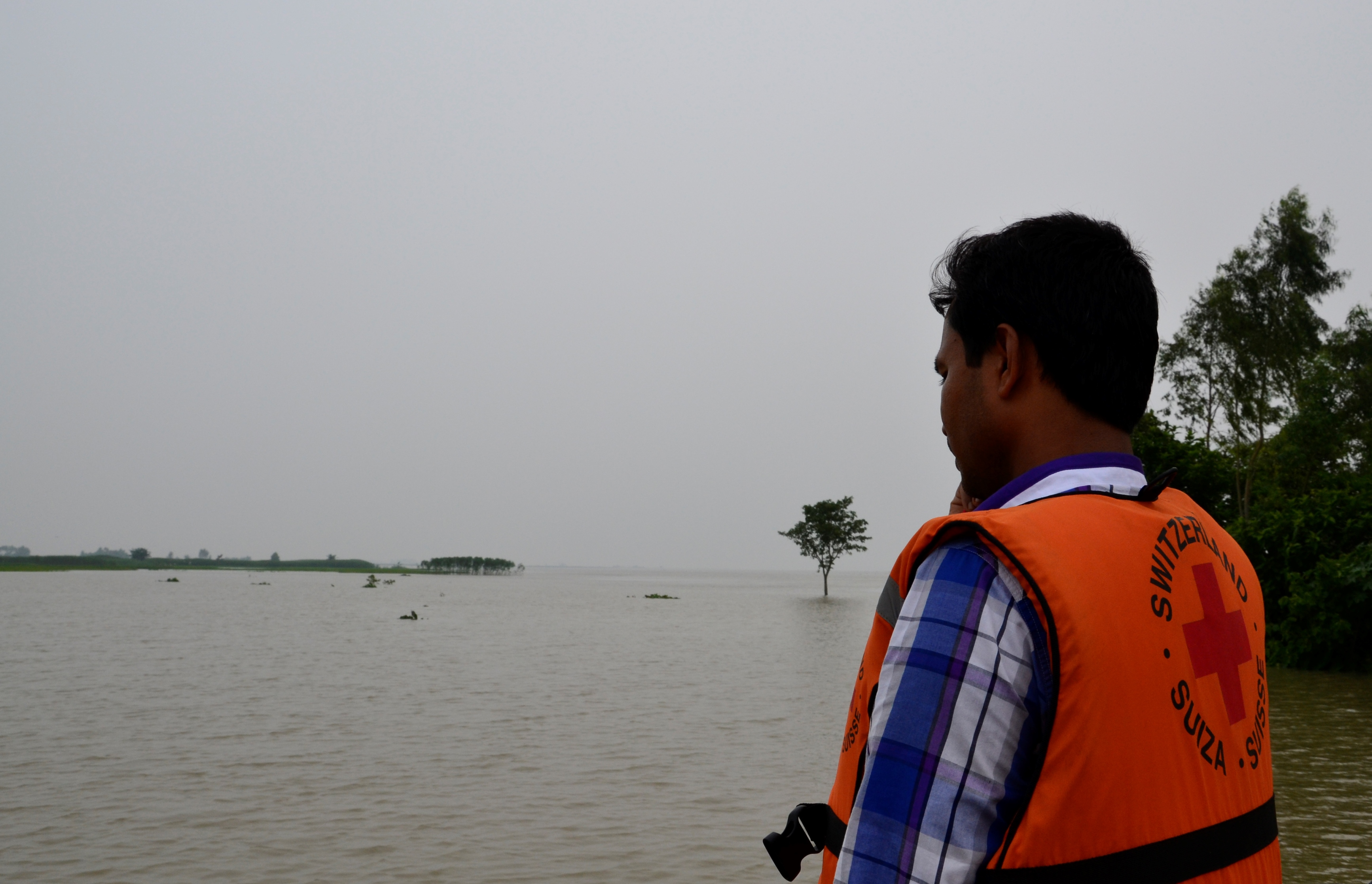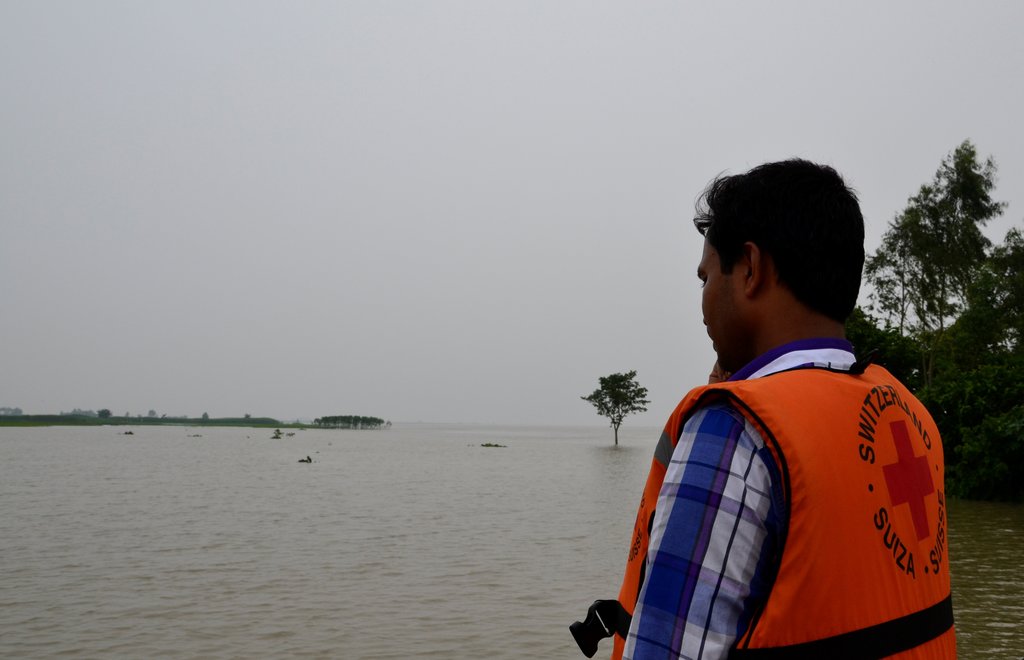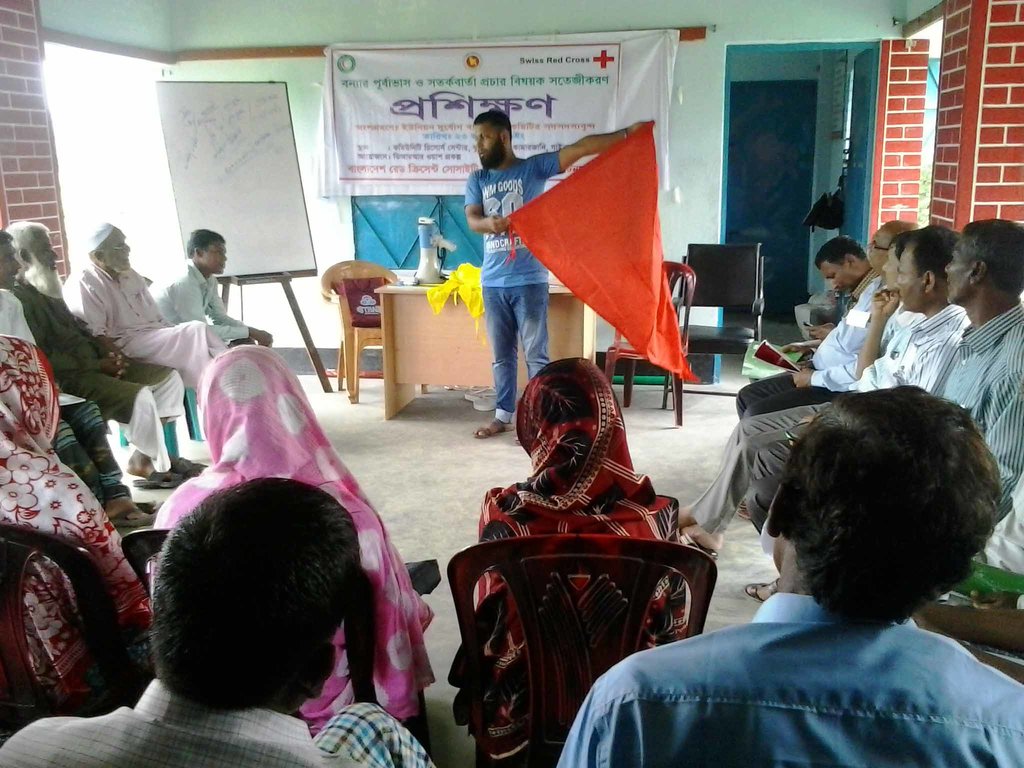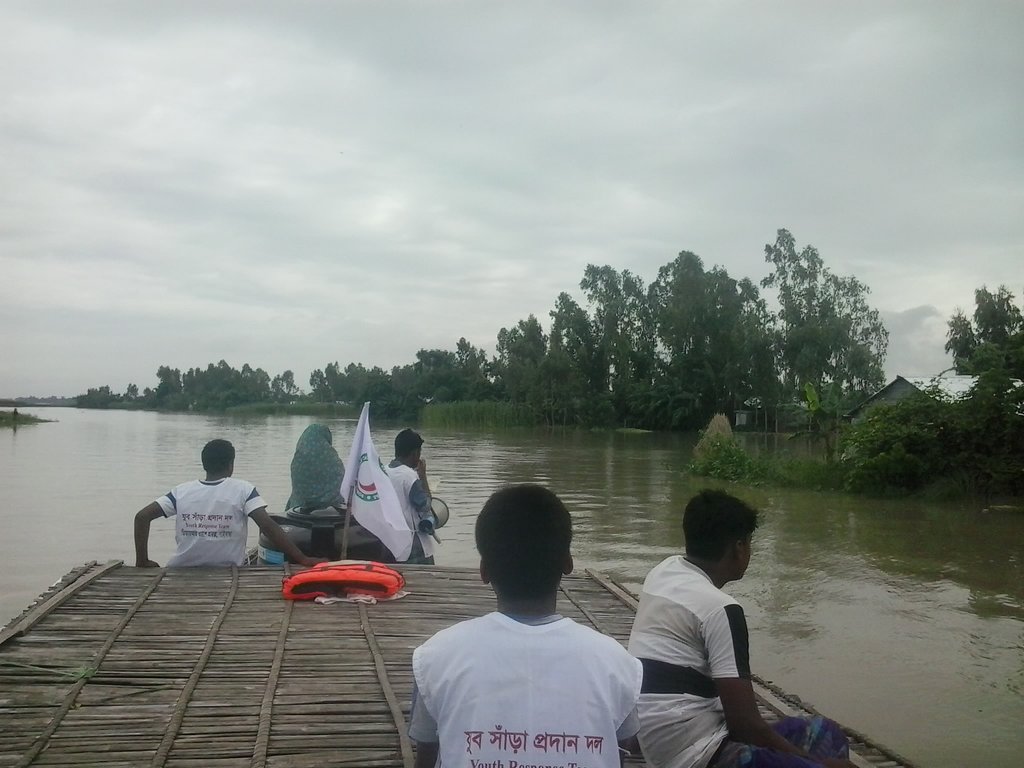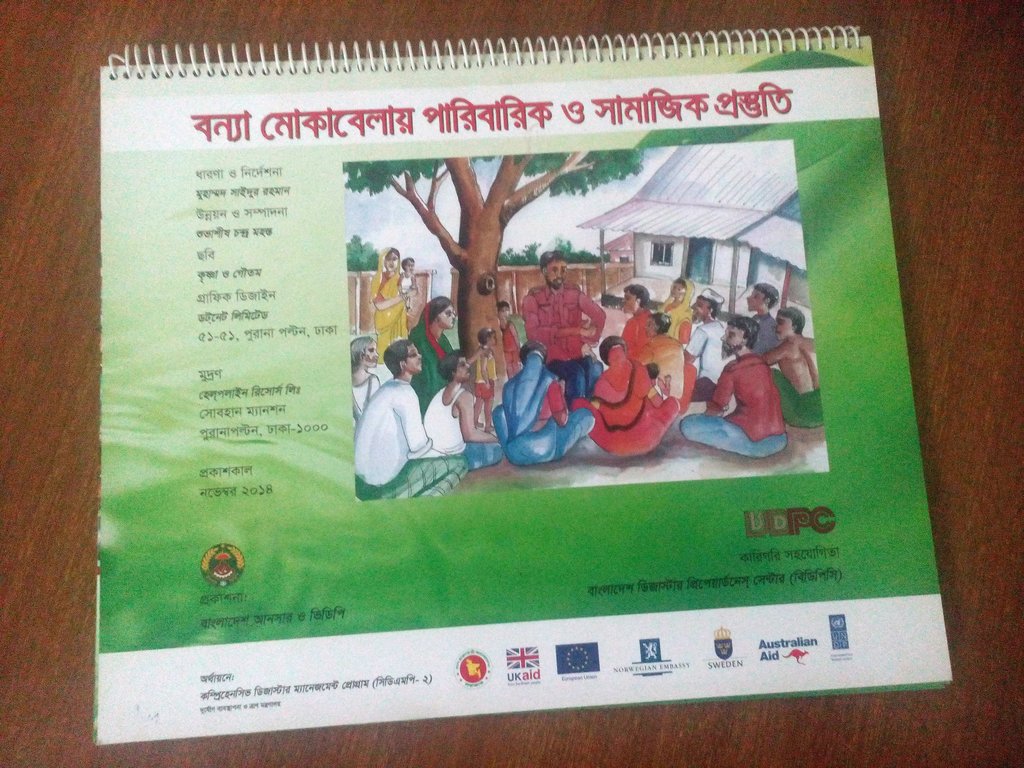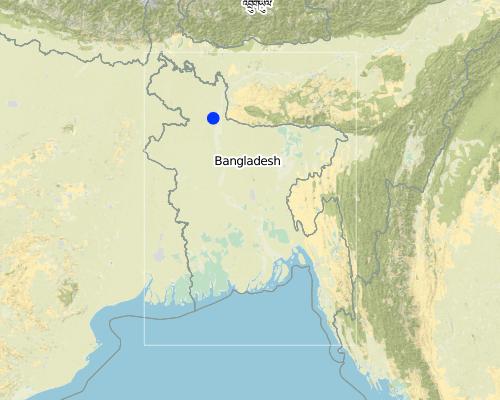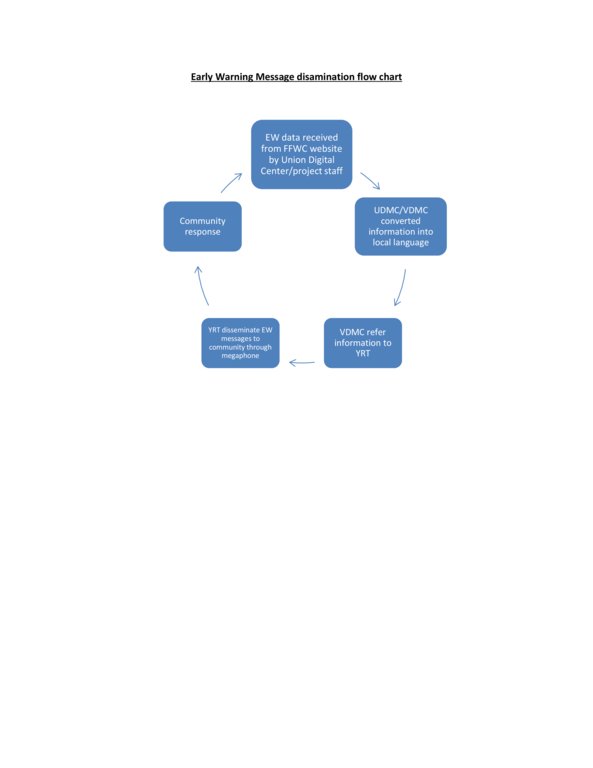Early Warning Message Dissemination [Bangladesh]
- Criação:
- Atualização:
- Compilador/a: TUHIN SAMADDAR
- Editor: –
- Revisores: Alexandra Gavilano, Alvin Chandra
বন্যা পূর্ব-সতর্কবার্তা প্রচার (Bonna Purbo-Satarkabarta Prochar)
approaches_649 - Bangladesh
Veja as seções
Expandir tudo Recolher tudo1. Informação geral
1.2 Detalhes do contato das pessoas capacitadas e instituições envolvidas na avaliação e documentação da abordagem
Pessoa(s) capacitada(s)
Project staff:
Mustafa Golam
+880 1718770373 / +880 1730799762
pmdrrwash16@gmail.com
Bangladesh Red Crescent Society
Project Manager, DRRWASH Project O⌀ਈce, Shukhsantir Bazar, Dhanghora, Gaibandha, Bangladesh
Bangladesh
Project staff:
Razzak Abdur
+880 1730 799763 / +880 1730 799763
razzak.pe@gmail.com
Bangladesh Red Crescent Society
Project Engineer, DRRWASH Project O⌀ਈce, Shukhsantir Bazar, Dhanghora, Gaibandha, Bangladesh
Bangladesh
Project staff:
Islam Saiful
+880 1730 799746 / +880 1730 799746
saiful644@gmail.com
Bangladesh Red Crescent Society
Field Officer DRR and Training, DRRWASH Project O⌀ਈce, Shukhsantir Bazar, Dhanghora, Gaibandha, Bangladesh
Bangladesh
Nome do projeto que facilitou a documentação/avaliação da Abordagem (se relevante)
Book project: where people and their land are safer - A Compendium of Good Practices in Disaster Risk Reduction (DRR) (where people and their land are safer)Nome da(s) instituição(ões) que facilitou(ram) a documentação/avaliação da Abordagem (se relevante)
Swiss Red Cross (Swiss Red Cross) - Suíça1.3 Condições em relação ao uso da informação documentada através de WOCAT
Quando os dados foram compilados (no campo)?
04/10/2016
O/a compilador/a e a(s) pessoa(s) capacitada(s) aceitam as condições relativas ao uso de dados documentados através da WOCAT:
Sim
1.4 Referência ao(s) questionário(s) sobre tecnologias da GST
2. Descrição da abordagem de GST
2.1 Descrição curta da abordagem
Early warning systems are an essential element in building resilience through effective disaster preparedness and risk mitigation: an effective system for dissemination of early warning messages was established among the vulnerable communities in Chars (riverine sandy islands) of Gaibandha district in order to strengthen their coping mechanisms and reduce loss and damage caused by floods.
2.2 Descrição detalhada da abordagem
Descrição detalhada da abordagem:
The key characteristics entail linking the intervention units at community level with national and sub-national early warning systems. It also consists of developing the capacity of the local government institutions and organised communities to not only disseminate early warning but to effectively respond to floods. The approach seeks to build upon existing local capacities and systems both in terms of dissemination of early warning and effective response. Merely installing an early warning system is not sufficient to equip communities to cope with recurrent floods; it needs to be linked to broader aspects of disaster preparedness and increased response capacity.
The vulnerability and capacity assessment (VCA) is the basis of all measures oriented at reducing disaster risks. The VCA was carried out with the involvement of local stakeholders, especially the target communities, to understand the vulnerabilities and risks associated with floods as well as to gain insight on existing capacities and capacity gaps that needed to be addressed. The process resulted in a risk reduction action plan which was to be jointly implemented by the target community and local government.
The risk reduction plan pointed to the need of having in place a mix of structural, management and contingency measures. This involved linking local, sub-national and national early warning systems, developing contingency and evacuation plans supported by establishment of safe places where people could move during floods. The risk reduction plan also highlighted the need to support household level protection measures - structurally this meant raising household plinth levels above flood levels. In addition, local early warning system was established through installation of flood markers/pillars, and warning flags at key sites. Capacities were built to internalise, monitor and consequently respond to evolving local flood situation. Building communication channels that linked the local institutions to higher level flood forecasting system resulted in streamlining information from source to destination.
2.3 Fotos da abordagem
Observações gerais sobre as fotos:
Approach of Early Warning System in DRRWASH project area in Gaibandha district.
2.4 Vídeos da abordagem
Comentários, breve descrição:
Video on Flood 2015 in the DRRWASH project area in Gaibandha including early warning intervention, in Bangla, link:
https://www.youtube.com/watch?v=Os4ZgSMMVyg
Data:
25/10/2015
Localização:
Gaibandha
Nome do cinegrafista:
Tuhin Samaddar and Vabotosh Karmakar
2.5 País/região/locais onde a abordagem foi aplicada
País:
Bangladesh
Região/Estado/Província:
North-Bengal
Especificação adicional de localização:
Kamarjani and Mollar Char union in Sadar Upazila and Haldia union in Shaghata Upazila of Gaibandha District
Comentários:
The entire intervention area is divided into 261 clusters. In each cluster, one local volunteer (YRT) has been nominated for preparedness and response operation. 30 Village Disaster Management Committee (VDMC) are actively monitoring the process under the guidance of three Union Disaster Management Committee (UDMC).
Map
×2.6 Datas de início e término da abordagem
Indique o ano de início:
2013
Caso o ano exato seja desconhecido, indique a data aproximada de início da abordagem:
menos de 10 anos atrás (recentemente)
Comentários:
N/A
2.7 Tipo de abordagem
- Baseado em projeto/programa
2.8 Principais metas/objetivos da abordagem
To promote resilient communities through improved flood preparedness that reduces loss and damage of vulnerable people's lives and protects their livelihoods in the chars of Gaibandha district.
2.9 Condição que propiciam ou inibem a implementação de tecnologia/tecnologias aplicada(s) segundo a abordagem
Normas e valores sociais/culturais/religiosos
- Propício
The intervention built upon traditional coping mechanisms and indigenous systems of disaster risk management. The blending of the traditional and indigenous practices with contemporary knowledge and preparedness practices acted as drivers in terms of choice and adoption of technologies.
- Inibitivo
In earlier phases of the intervention, the cultural norm of not abandoning one's household even in extreme crisis hindered timely access to emergency infrastructure.
Disponibilidade/acesso a recursos e serviços financeiros
- Propício
The DRR intervention facilitated leveraging of institutional financial resources (Local government budget) and secured cost contribution from target communities.
- Inibitivo
Lack of adequate capacities and resources with local government.
Quadro institucional
- Propício
The Disaster Management Act and Standing Orders on Disaster of the Govt. of Bangladesh provides for a decentralised disaster management institutional setting from the central level to the local level.
- Inibitivo
In principle a decentralised disaster management structure is in place but due to operational and financial constraints they are unable to perform their mandated function.
Colaboração/coordenção de atores
- Propício
The initiative built a good coordination with state actors at various levels. From time to time it was also able to secure collaboration from non-state actors around specific thematic areas.
- Inibitivo
Harmonisation of disaster centred initiatives is a time consuming process and very often does not lead to collaborations that harness existing synergies.
Quadro jurídico (posse de terra, direitos de uso da terra e da água)
- Propício
Disaster Management Act, 2012 provides the legal framework for disaster risk management in Bangladesh.
Políticas
- Propício
A set of policies supports the Disaster Management Act. Government's standing orders on disaster clearly defines the roles and responsibilities of various ministries, line agencies, local govt., mandated committees and other non-state actors in disaster risk management.
- Inibitivo
Policy enforcement across sectors remains weak in Bangladesh.
Governança da terra (tomada de decisões, implementação e aplicação)
- Propício
Traditional rights to land are still accepted in Chars of Bangladesh .
- Inibitivo
Land ownership is complex in Chars given its unstable nature due to high vulnerability to river erosion. Elite capture of land is overwhelmingly practiced in the Chars.
Conhecimento sobre GST, acesso a suporte técnico
- Propício
Early warning systems have strengthened land management practices.
- Inibitivo
River erosion threats strongly disincentivise investment in SLM.
Mercados (para comprar entradas, vender produtos) e preços
- Inibitivo
Market forces are yet to develop properly in Chars which are by nature isolated geographical units, accessed only through time consuming and expensive transportation means.
Carga de trabalho, disponibilidade de força de trabalho
- Propício
Higher productivity of land in Chars allow for lower labour engagement in agriculture.
- Inibitivo
Disaster and higher profitability in mainland drives migration leading to labour shortages.
3. Participação e papel das partes interessadas envolvidas
3.1 Partes interessadas envolvidas na abordagem e seus papéis
- Organizações comunitárias
Village Disaster Management Committee (VDMC)
The VDMC is the key actor to perform disaster risk reduction activities in the communities. This covers supporting the conduct of VCA and developing their action plans based on VCA findings. The operationalisation of the plans is anchored in the VDMC and so is leveraging cooperation and collaboration from local government. The VDMC also acts as first responder and as custodian responsible for O&M of built emergency and health infrastructure. Assessing community needs, beneficiary selection, contribution collection and financial management of hardware are their other key responsibilities.
- Professores/alunos/estudantes
Youth Response Team (YRT) members
YRT has been developed to promote volunteerism. Their main role is to support response and recovery operations during and after disaster. They are especially trained in Search & Rescue. As they are located in the community, YRTs actively engage in early warning dissemination.
- Setor privado
Enterpreneur of Union Digital Center
The lowest level of local government, the Union Parishad (UP), has a Digital Center to render ICT services to communities. These are run by local entrepreneurs. The entrepreneurs are responsible for monitoring flood forecasts on the internet and updating the UP and CBOs on evolving flood situation. By analysing and interpreting relevant information they play a key role in catalysing the early warning system.
- Governo local
Union Disaster Management Committee (UDMC)
The UDMC disseminates forecasts, warnings, and advisories locally. It also performs a lead role in response and recovery operations.
Caso várias partes interessadas foram envolvidas, indique a agência líder:
UDMC
3.2 Envolvimento do usuários de terra/comunidades locais nas diferentes fases da abordagem
| Envolvimento do usuários de terra/comunidades locais | Especifique quem estava envolvido e descreva as atividades | |
|---|---|---|
| Iniciação/motivação | Participativo | Key Actors: VDMC/CBOs and Local Government Institutions (UDMC) Activities : Baseline survey, formation of CBOs, reformation of UDMC, VCA and volunteer selection |
| Planejamento | Participativo | Key Actors: VDMC/CBOs and Local Government Activities: preparation of risk reduction action plan, preparation of evacuation plan along with route map, contingency plan development, planning of emergency and health infrastructure, Early Warning Systems (EWS) planning |
| Implementação | Participativo | Key Actors: VDMC/CBOs and Local Government Activities: Establish Early Warning System, emergency infrastructure, access infrastructure (wooden bridge, roads, etc.), household infrastructure |
| Monitoramento/avaliação | Automobilização | Key Actors: VDMC/CBOs, Local and Sub-national Government Activities: Developing Quality Assurance System, Community Review Meeting, Site visits/physical verification, quality and financial audit, survey and spot checks, |
| Initiation | Automobilização | Ket Actors: VDMC/CBOs, Local Government and Private Sector: Activities: O&M of built infrastructure and Sanitation Marketing |
3.3 Fluxograma (se disponível)
Descrição:
The flow chart explains application of the EWS and clarifies local linkages with national flood forecasting and warning centre (FFWC)
Autor:
Tuhin Samaddar
3.4 Decisão sobre a seleção de tecnologia/tecnologias de GST
Especifique quem decidiu sobre a seleção de tecnologia/tecnologias a serem implementadas:
- todos os atores relevantes, como parte de uma abordagem participativa
Explique:
Since participatory approach has been adopted to examine vulnerabilities and capacities, the approach and technology choice to address risk and vulnerabilities was collectively decided.
Especifique em que base foram tomadas as decisões:
- Resultados de pesquisa
- Experiência pessoal e opiniões (não documentado)
- Government policies and mandates
4. Suporte técnico, reforço das capacidades e gestão do conhecimento
4.1 Reforço das capacidades/ formação
Foi oferecida formação aos usuários da terra/outras partes interessadas?
Sim
Especifique quem foi capacitado:
- Usuários de terra
- Equipe de campo/consultores
- Anser-VDP (Village Defence Party) member
Tipo de formação:
- Áreas de demonstração
- Reuniões públicas
- Cursos
Assuntos abordados:
Several training courses and workshops were organised on disaster preparedness and response:
1. Early Warning System (for UDMC/VDMC/ Anser-VDP/YRT/VCRP/Staff): Disaster context in Bangladesh, techniques to identify water levels against standardised danger levels, determining flood intensity by observing pillars and flags, dissemination strategies for early warning messages among the community, and role of stakeholders to warning message dissemination.
2. Evacuation Plan (for VDMC/YRT/VCRP): Response operation, preparing checklist for response, preparing risk and resource map, information collection and analysis, preparing route maps, and roles and responsibilities of respective stakeholders in effectuating evacuation plan
3. Response Plan (for UDMC): Importance of response plan, ke constituents of preparedness and response, interpretation of Early Warning information from FFWC, creating contingency fund, search and rescue, emergency relief and first aid, identifying safe exit route and transportation, damage assessment, launching control room, involving existing manpower and resources in the community and other organisation, and prepositioning of rescue equipments.
Comentários:
609 VDMC/UDMC members were trained on various DRR topics. 255 local youth volunteers (YRT/VCRP) were also trained on early warning message dissemination, flood forecast interpretation, preparing evacuation plan and route map.
4 mock drill demonstration events were conducted by local government in which 276 community members participated. Refresher training was also organised for newly elected union parishad members on their broad mandate with specific reference to their roles and responsibilities in disaster risk management.
4.2 Serviço de consultoria
Os usuários de terra têm acesso a um serviço de consultoria?
Não
4.3 Fortalecimento da instituição (desenvolvimento organizacional)
As instituições foram fortalecidas ou estabelecidas através da abordagem?
- Sim, significativamente
Especifique a que nível (níveis) as instituições foram fortalecidas ou estabelecidas:
- Local
- Regional
Descreva instituição, papéis e responsabilidades, membros, etc.
CBOs/Village Disaster Management Committee (VDMC)- on an average each CBO/VDMC has 17 members. Their roles and responsibilities entail assessments, beneficiary selection, developing and implementing RRAPs with special focus on disaster preparedness and response. A key function entails their engagement in EWS and planning and implementation of emergency and health infrastructure, shelter protection, and creating access infrastructure. O&M of all built assets and infrastructure is their responsibility.
Local Government/UDMC: on average it has a 36 members. Standing orders on disaster of the government defines their roles and responsibilities which covers the entire gamut of functions associated with disaster risk management at the local level. Strengthening preparedness and leading effective response is critical to their mandate.
Especifique o tipo de apoio:
- Reforço das capacidades/ formação
- Equipamento
Dê mais detalhes:
Megaphone, stretcher, Lifejacket, Lifebuoy, Torchlight, Raincoat, Gumboot, Rope and First aid box are some of the equipments that have been given. Further, the YRTs have received whistle, umbrella and apron for early response operation
4.4 Monitoramento e avaliação
Monitoramento e avaliação são partes da abordagem?
Sim
Comentários:
A joint monitoring team has been formed comprising representative of CBOs, local government and project staff.
Caso afirmativo, esta documentação é destinada a ser utilizada para monitoramento e avaliação?
Não
4.5 Pesquisa
A pesquisa foi parte da abordagem?
Não
5. Financiamento e apoio material externo
5.1 Orçamento anual para o componente de GST da abordagem
Indique o orçamento anual para o componente de GST da abordagem em US$:
10384,00
Caso o orçamento exato seja desconhecido, indique a faixa:
- 10.000-100.000
Comentários (p. ex. principais fontes de recursos/principais doadores):
Swiss Red Cross
Above mentioned amount is for the Early Warning System Implementation approach only
5.2 Apoio financeiro/material concedido aos usuários da terra
Os usuários da terra receberam apoio financeiro/material para a implementação de tecnologia/tecnologias?
Não
5.3 Subsídios para entradas específicas (incluindo mão-de-obra)
- Nenhum
Se a mão-de-obra pelos usuários da terra foi uma entrada substancial, isso foi:
- Voluntário
Comentários:
All actions related to dissemination of early warning were performed on a voluntary basis.
5.4 Crédito
Foi concedido crédito segundo a abordagem para atividades de GST?
Não
5.5 Outros incentivos ou instrumentos
Foram utilizados outros incentivos ou instrumentos para promover a implementação das tecnologias de GST?
Não
6. Análise de impactos e declarações finais
6.1 Impactos da abordagem
A abordagem concedeu autonomia aos usuários locais de terra, melhorou a participação das partes interessadas?
- Não
- Sim, pouco
- Sim, moderadamente
- Sim, significativamente
The participation of all local stakeholders, especially women, has improved considerably.
A abordagem propiciou a tomada de decisão baseada em evidências?
- Não
- Sim, pouco
- Sim, moderadamente
- Sim, significativamente
The decision making especially with regard to effectiveness and quality of approach and technologies has been determined by the evidence on the ground.
A abordagem auxiliou os usuários da terra a implementar e manter as tecnologias de GST?
- Não
- Sim, pouco
- Sim, moderadamente
- Sim, significativamente
Since the implementation of technologies and maintenance of built infrastructure has been largely user led, it has improved their capacity to do the same.
A abordagem mobilizou/melhorou o acesso aos recursos financeiros para implementação da GST?
- Não
- Sim, pouco
- Sim, moderadamente
- Sim, significativamente
User contribution and govt. contribution was a mandatory component of the project which led to mobilisation of resources that supplemented project resources.
A abordagem aprimorou o conhecimento e as capacidades de outras partes interessadas?
- Não
- Sim, pouco
- Sim, moderadamente
- Sim, significativamente
Implementation of well designed capacity building plan cognizant of the needs of diverse stakeholders has improved the knowledge and capacities of relevant stakeholders.
A abordagem construiu/fortaleceu instituições, colaboração entre partes interessadas?
- Não
- Sim, pouco
- Sim, moderadamente
- Sim, significativamente
the central element of the approach has been to ensure sustainability of benefits which cannot be attained without strong institutions collaborating around DRM work. Thus, the approach led to improved collaboration between stakeholders and strengthened institutions.
A abordagem atenuou conflitos?
- Não
- Sim, pouco
- Sim, moderadamente
- Sim, significativamente
The approach is based on conflict sensitive programme management. This allowed for pro-active identification of conflicts and tensions followed by measures aimed at their mitigation.
A abordagem concedeu autonomia aos grupos social e economicamente desfavorecidos?
- Não
- Sim, pouco
- Sim, moderadamente
- Sim, significativamente
The extreme poor and socially disadvantaged were especially targeted by the disaster preparedness approach
A abordagem melhorou a igualdade de gêneros e concedeu autonomia a mulheres e meninas?
- Não
- Sim, pouco
- Sim, moderadamente
- Sim, significativamente
Though significant improvements are there as women and girls are much more aware about disaster preparedness in general and flood response in particular, there remains room for further improvement.
A abordagem resultou em acesso melhorado à água e ao saneamento?
- Não
- Sim, pouco
- Sim, moderadamente
- Sim, significativamente
As part of strengthening preparedness to health hazards, WASH infrastructure set up by the project has greatly improved access to water and sanitation
A abordagem aprimorou a capacidade dos usuários da terra de adaptar-se a mudanças climáticas/extremos e atenuar os desastres relacionados com o clima?
- Não
- Sim, pouco
- Sim, moderadamente
- Sim, significativamente
Strengthened DRM capacities include improved climate adaptation and capacities to mitigate climate induced disasters.
6.2 Principal motivação dos usuários da terra para implementar a GST
- Riscos de desastre reduzido
Early warning system helps people prepare and act before the water level crosses danger level (which denotes the settlement is at risk of inundation)
6.3 Atividades de sustentabilidade de abordagem
Os usuários da terra podem manter o que foi implementado através da abordagem (sem apoio externo)?
- Sim
Caso afirmativo, descreva como:
Union Digital Center is an information hub that exists in the union where people have easy access. The technology is simple and the approach is easy to understand and has already benefited the targeted community. The anchoring of preparedness in general and EWS in particular in local government and its rolling out in collaboration with communities imparts high probability of sustainability to disaster preparedness measures. During the project cycle, two flood events of significant magnitude have tested the approach and technology and resulted in tangible benefits for the community. At the same time since sustainability considerations are inbuilt in project design and have guided the implementation of the approach and technology, the likelihood of their sustainability is very strong.
6.4 Pontos fortes/vantagens da abordagem
| Pontos fortes/vantagens/oportunidades na visão do usuário da terra |
|---|
|
Strengths: - A trained group of volunteer is available in the community - Response equipments are in place and ready to use if and when needed - EWS facilitates people's timely access and movement to appropriate emergency infrastructure and protected shelters |
|
Advantages: - Rapid evacuation, especially for physically challenged, children and elderly people, and cattle - Crops are saved due to timely action related to sowing and harvesting. - Means of preparedness, such as boat, banana raft, portable cooker, firewood, ORS, dry food can be collected beforehand |
|
Opportunities: - Balanced representation of community in govt. mandated disaster committees - Coordination/ communication with development actors and local govt./union parishad is more forthcoming |
| Pontos fortes/vantagens/oportunidades na visão do/a compilador/a ou de outra pessoa capacitada |
|---|
|
Strengths: - Sustainability dimensions have been well considered and applied in adopted approach and technologies - Strengthened community institutions are in place to address DRM issues, especially those related preparedness and response mechanisms |
|
Advantages: - Community and local government interface has been strengthened to devise appropriate DM solutions - Decisions on preparedness approach and attendant technologies are taken collectively by stakeholders |
|
Opportunities: - A replicable model of EWS, emergency and access infrastructure has been established |
6.5 Pontos fracos, desvantagens da tecnologia e formas de superá-los
| Pontos fracos/desvantagens/riscos na visão do usuário da terra | Como eles podem ser superados? |
|---|---|
| - Long term maintenance of response equipments |
- UDMC should play custodian's role - Local people should contribute towards recurrent cost |
| Pontos fracos/vantagens/riscos na visão do/a compilador/a ou de outra pessoa capacitada | Como eles podem ser superados? |
|---|---|
| - Replicability of the model might be difficult due to lack of funds and functionaries available with local government. |
- Support local government in negotiating more resources from higher levels of governance and administration. - Build capacity of local government to utilise resources efficiently and effectively. |
7. Referências e links
7.1 Métodos/fontes de informação
- entrevistas com usuários de terras
15 - Key Informant Interview (KII)
2- Focus Group Discussion (FGD)
- entrevistas com especialistas em GST
4
- compilação de relatórios e outra documentação existente
6
7.2 Referências às publicações disponíveis
Título, autor, ano, ISBN:
Three VCA Reports published by UDMC with support of DRRWASH project
Disponível de onde? Custos?
Bangladesh Red Crescent Society
7.3 Links para informação relevante que está disponível online
Título/ descrição:
Flood Forecasting & Warning Centre (FFWC), Bangladesh Water Development Board (BWDB), SOD
URL:
http://www.ffwc.gov.bd/#, http://ddm.portal.gov.bd/sites/default/files/files/ddm.portal.gov.bd/page/a3f4cc27_7f7d_4c2b_a1b0_166fe6bef73b/udmc.pdf
Links e módulos
Expandir tudo Recolher tudoLinks
Não há links
Módulos
Não há módulos


